Effective Bobber Doggin For Steelhead And Salmon
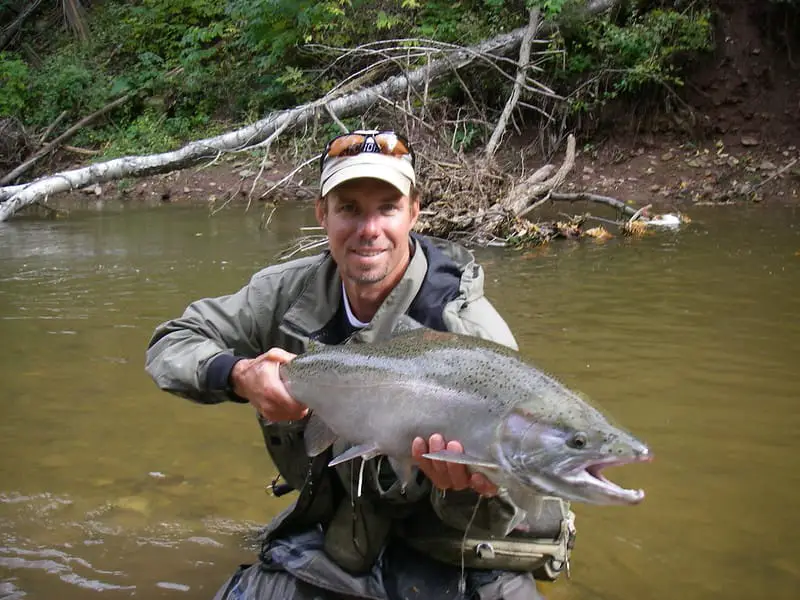
After river fishing for over 37 years and guiding for over 20 years, I thought I’d seen it all, but, then came bobber doggin. Like every river fishing method that exists, I had to give it a try and see if it was effective or not.
Bobber Doggin originated on West Coast rivers for steelhead and salmon, but it can also be used when river fishing for trout and river bass. It is an easy-to-use method that keeps your bait in the strike zone and has good strike detection, which is ideal for new river anglers or for kids.
I’ve split-tested Bobber Doggin and other common river fishing methods to compare results. I will provide my honest opinion on whether this new method is worth a try and when I think it might be better.
What Is Bobber Doggin?
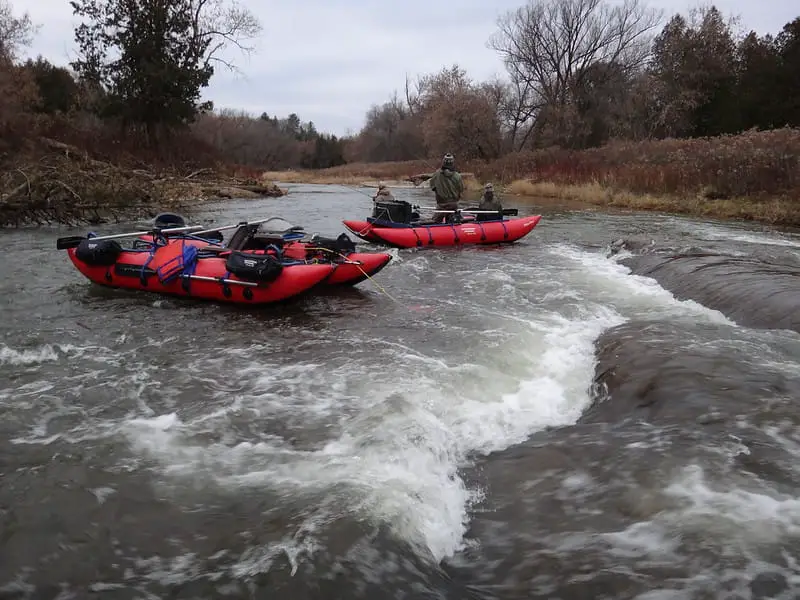
I’ve been hearing about this method since around 2016.
It can be done from shore, while wading, or from a moving or stationary river boat like my boats in the above picture.
Similar to float fishing, bobber doggin is a fishing technique that will help you cover more water while keeping your bait in the optimal location, or “strike zone,” for a longer period of time.
If you are fishing from a boat, bobber doggin can also make it easier for the boat operator to get positioned well in relation to the wind or current. It also works well if the boat slowly moves down the river.
If you are wading in the river or fishing from the bank, you can fish while standing still or even slowly walk down the river as your bobber and bait drift along.
The angler can be positioned above or below the float and bait.
Bobber Dogging Presentation
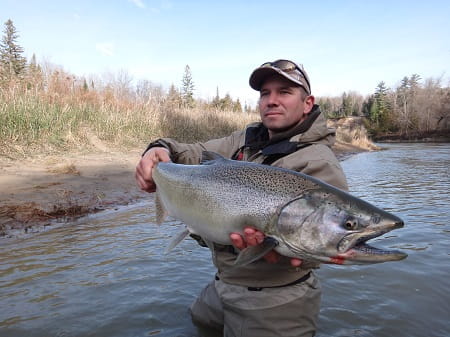
Bobber doggin is believed to create a presentation that fish find to be very appealing because it is closer to what the fish would encounter naturally, meaning the bait is moving slowly along the bottom and possibly bumping along the rocks and river bed.
A slower moving bait mimics the natural food better, and it gives the fish more time to see and then grab the bait.
Is Bobber Doggin Easy?
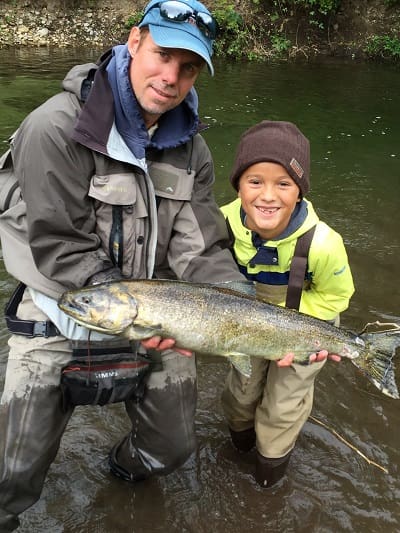
Bobber doggin is also very easy to set up and very easy for the beginner angler compared to the traditional side drifting method or float fishing method.
To do it, I cast at a 45-degree angle upstream and then walk down the bank as the rig begins to drift. The bobber will be upstream or downstream of you as you move along. You also won’t be casting and recasting as often if you walk with your bobber.
You really don’t need to do anything else which is why this method is so easy. In fact, you don’t even need to walk along with the bobber. You can simply cast it out and let it go.
I keep the line up and off the water as much as possible, but some angler prefer their mainline to stay below the bobber in a bit of a belly on the waters surface. This almost pulls the bobber along or maintains the bobbers downward angle.
If the bobber gets too far downriver from you it’s hard to keep the line belly below the bobber so angler migh choose to walk with the bobber..
If you stand still, just let slack out to maintain the belly in the line below the float, but be sure to reel up that slack first before you set the hook.
Bobber Doggin Vs Float Fishing
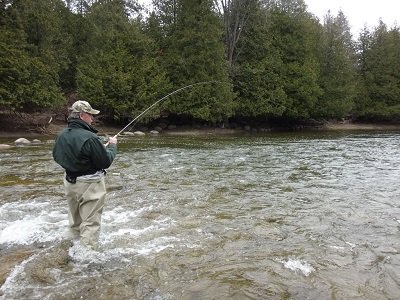
Bobber doggin is known to be easy and effective, but is it better than traditional suspension float fishing?
The answer depends on the angler doing each method. Bobber doggin is easy and allows your bait to hang in the water in a way that is somewhat natural.
The way the leader is drawn away from your weighted line mimics the way a fish’s favorite food might dangle in the water if it was caught in swirling undercurrents or if it was being pulled by the current.
If you are a new angler, then bobber doggin might be better for you. However, a very good float angler should catch a lot more fish using the float fishing method. There are many technical reasons for this.
With float fishing, a good angler will also be able to very effectively control the speed and depth of the bait. And, if done well, for most of the drift none of your rig or bait will be touching the bottom, therefore, your bait is in the strike zone, moving at the right speed, and strike detection is much better, and you are less likely to get snagged.
Also, it is proven that fish feed upwards over 80 percent of the time so a bait suspended by a float should be better.
The problem is that most suspension float-fishing anglers fish poorly, and, for this reason, bobber doggin might be better. It’s pretty hard to screw it up.
With float fishing, your bobber suspends your bait off the bottom. But, with bobber doggin, the current pulls the float and the weight, which is drags the bait along the bottom. There are many potential downsides to a dragging bait.
With the weight dragging on the bottom, it could also drag the bait too fast.
The weight dragging the bait behind it also means the thicker mainline is between the bait, which is upstream, and the fish which is downstream. In this situation, the line or the weight could spook the fish since the fish see that first.
Also, as the bait comes down the river and the fish moves in line with the bait, the line might even bump the fish in the face, This is also a great way to spook the fish.
Because the weight is dragging along the bottom, the lighter bait can be dragging behind it, or the bait can also be up above the weight if the current takes it there, or the bait can be sideways to the weight, or even downriver of the bait and leading the way.
The bait sideways to the weight is the most ideal situation, but I always have an issue with a bait that is going downriver first and way ahead of the bobber as this is horrible for strike detection, and it can mean the fish has a lot more time to spit the bait out before your bobber drops and you even know the fish is on.
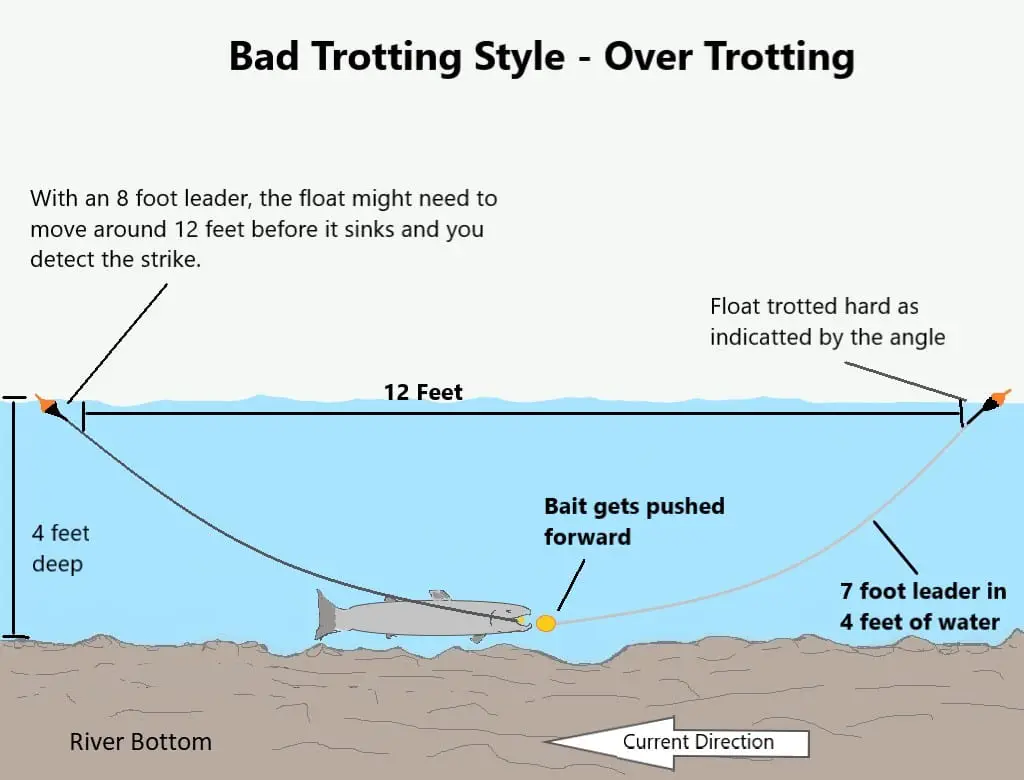
The diagram above shows the issues with the bait going too far forward when float fishing.
The same issue is true for bobber doggin, just not to the same extent unless you have a very long leader below your weights.
The longer your leader, the more this can be an issue.
Benefits Of Bobber Doggin
The primary advantage that I see would be in situations where you needed to cast upriver and then let the bobber and bait drift back to you. It’s near impossible to control your speed and get a good drift when you cast upriver when suspension float fishing, but with bobber doggin the weight should slow your bait down.
The other advantage to bobber doggin is the bait gets deep and stays deep. Even if the river gets deeper, or has deep spots, the bait stays down.
The other primary advantage is it’s easy for all anglers to do it well.
Species You Can Catch With Bobber Doggin
What kinds of fish can we expect to catch? Most often you will see steelhead and salmon anglers using this method.
Here are the fish that tend to like this technique most and where they are most often found.
- Steelhead: North American, especially where temperatures are cold
- Salmon: The Great Lakes, Europe, and Patagonia
- Trout: Almost any river
- Smallmouth Bass: This can be excellent for smallmouth bass in rivers.
- Carp: Freshwater in Asia, Europe, and North America
- Northern Pike: River pike all across the Northern Hemisphere
- Crappie: Freshwater all across North America
- Yellow Perch: North American rivers, especially the Mississippi River
- Walleye: Freshwater rivers in North America and Canada
How To Do Bobber Doggin
Bobber doggin can be done from a drift boat or jet sled. In fact, that is the way it is most often done.
In the boat, the anglers can drift the boat down the river and have their bobbers drifting out and beside the boat. You can drift for miles with this setup if the river bottom doesn’t get too deep.
If the river is five feet deep you can set your bobber to seven to twelve feet deep. If the river gets deeper your bait and weight will still remain on the bottom. The only time you will need to adjust your weight is if it gets much deeper than the line is below your bobber.
Bobber doggin is not good in very shallow water of two feet or less for a few reasons, primarily that the float might spook the fish.
When doing bobber doggin by boat or by foot, the top of your bobber should be angled downstream since your sinker will be dragging on the bottom.
Notice that this is the opposite of how you would want your bobber if you were using a more traditional float fishing presentation.
The ideal speed will be determined by the conditions of the water and will take some practice to learn. Faster water means a faster presentation.
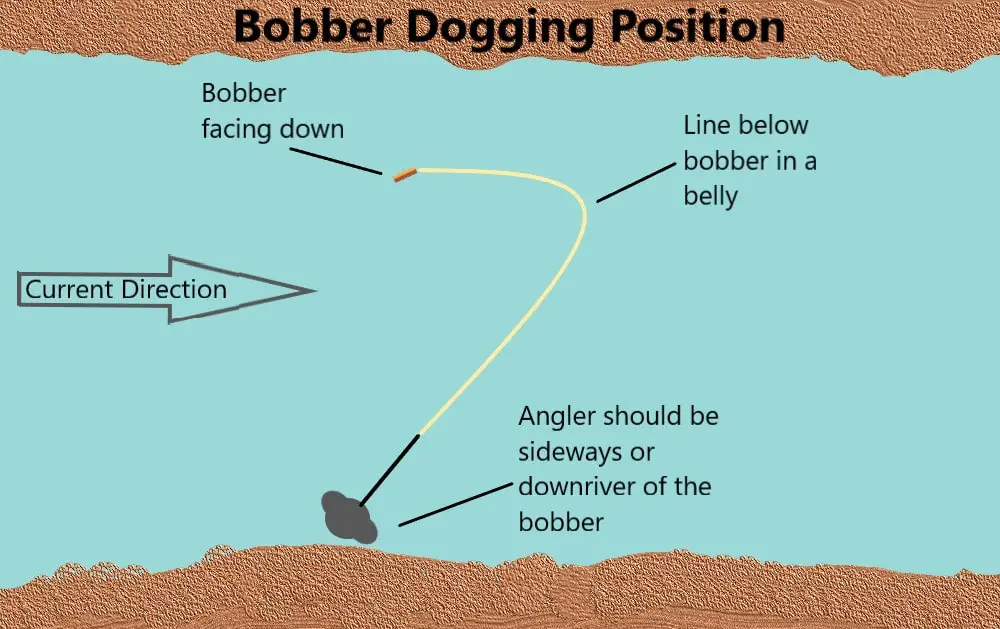
Ideally, you also want your line to be below your bobber in a belly or half-moon shape. This keeps your bobber facing downriver. If your line is upriver and tight, your bobber will tilt upriver which you don’t want.
Simply watch the bobber and set the hook if it stops or goes down.
What Do You Need For Bobber Doggin?
Here is a setup recommended for steelhead fishing.
- Standard float rod between 8.5 to 9.5 feet in length.
- Any type of reel will do fine.
- 30-pound braid.
- 8 to 15-pound fluoro or mono leader.
- Roe and Fish Pill or Corkie.
- No #10 to #4. Octopus hook.
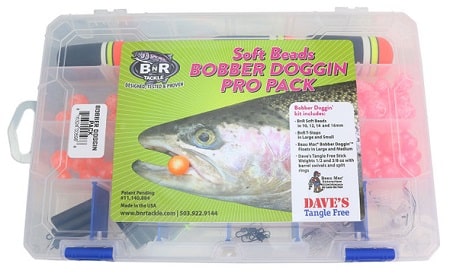
If you are looking to get into bobber doggin and want a full setup you could check out the BnR Tackle Bobber Doggin Starter Pack.
The BNR Bobber Doggin Kit includes:
- Complete Bobber Doggin Pack
- BnR Tackle Bobber Doggin Pack includes:
- BnR Soft Beads in 10,12,14 and 16 mm in size of the fishiest colors
- BnR T-Stops in large and small
- Beau Mac Bobber Doggin Floats in large and medium sizes
- Dave’s Tangle Free Stick Weights 1/2 and 3/8 oz. with barrel swivels and split rings
- Pack includes 144 beads (6 of each color and size)
Setting Up Your Rig
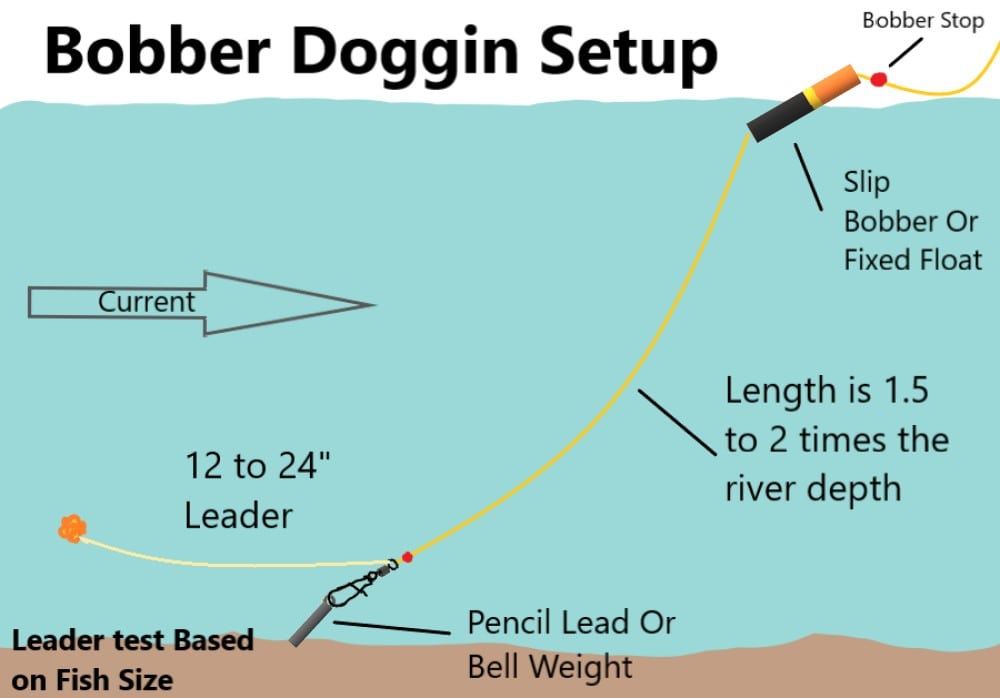
1. Attach your bobber
2. Attach your first bead
3. Attach your float
4. Attach your second bead
5. Attach your swivel
6. Use a Palomar knot
7. Attach your leader and bobber stop
8. Attach your bead
9. Tie the leader onto the swivel using a clinch knot
10. Attach your weight to the swivel
The Bobber Doggin Rigs
No matter what kind of fish you’re after, the rig will look similar. But your line strength, float sizes, weight sizes, and bait types will change.
You may also need to change your weight size based on the current speed and depth. As an example, a big heavy weight might be perfect in faster water, but in slow water, it will probably anchor to the bottom and not drift properly or drift at all.
The right amount of weight will get your bait and weight down to the bottom while bouncing along the bottom and maintaining a speed slightly slower than the current.
What Are Bobber Doggin Bobbers
Most anglers will use slip bobbers with bobber stops and beads and these do work well, especially in deeper water over twelve feet deep. However, you can also use a fixed float, or fixed bobber, which is a bobber that does not slide up and down the line.
Fixed floats are good in shallow water under twelve feet. I’ve tried both types of floats with equal success. You can use any river float that the guys use for float fishing.
Bobber Doggin For Steelhead
For steelhead, a stronger line is recommended. Like in the setup described above, a 30-pound braided line or 12-pound mono line is best. In general, the bigger the river, and the stronger the current, the stronger you want your line to be.
The leader should be 12″ to 30″ long
The leader should be 6 to 10 pounds for Great Lakes steelhead and will depend on the current size, speed of current, and clarity.
For west coast steelhead 12 to 15 pound mainline and 10 to 14 pound leader.
Bobber Doggin For Salmon
When bobber doggin for salmon, use a 12 to 15-pound mono mainline, and 12 to 30-inch leader that is 10 to 12 pounds for Great Lakes salmon, and a 12 to 16-pound leader for West Coast salmon.
Again, the bigger the river, the bigger the fish will be, and you’ll need to adjust your line and weights accordingly.
Bobber Doggin For Trout
For trout, use an 8 to 12-size bait hook and a medium sliding bobber. Use a 6 to 8-pound test mono line or fluorocarbon line, a bobber stopper, and split shot weights.
Remember to use lighter lines and weights in smaller rivers.
2 to 6-pound leaders are great for most river trout unless you are fishing for giant migratory Great Lakes brown trout like this one caught by our photographer Matthew.
How Long Is A Bobber Doggin Leader?
The recommended length will change based on conditions and the fish you are trying to catch. Many anglers will recommend a three to five-foot leader line but I believe these long leaders put you at risk of missing a bite, as I described above.
I use a 12″ to 30″ leader.
How Heavy Is The Weight When Bobber Doggin?
The recommended weight will change for the speed and depth of the river. Standard bobber doggin kits will come with sets of weights between 3 and 8 ounces. You’ll have to choose one based on prevailing conditions.
Is Bobber Doggin Effective?
As a guide and avid angler for over 22 years, I can honestly say I live and breathe fishing. While I’m on the water either guiding or fishing for fun, I analyze everything to try to determine if it’s good, or bad, or how I can improve it. I did this with bobber doggin and have come to this conclusion.
Is bobber doggin effective, YES!
Is it the most effective method to use, NO!
Would I continue to use it when fun fishing or with clients, NO!
My Bobber Doggin Conclusion
This may not be a welcome statement among some anglers but I’m not one to BS to keep people happy.
In my opinion, Bobber Doggin is the lazy-man’s float fishing method and is far less effective than regular float fishing in most situations, and I just can’t recommend something that’s less effective, even if it does catch some fish sometimes.
Tight Lines,
Graham

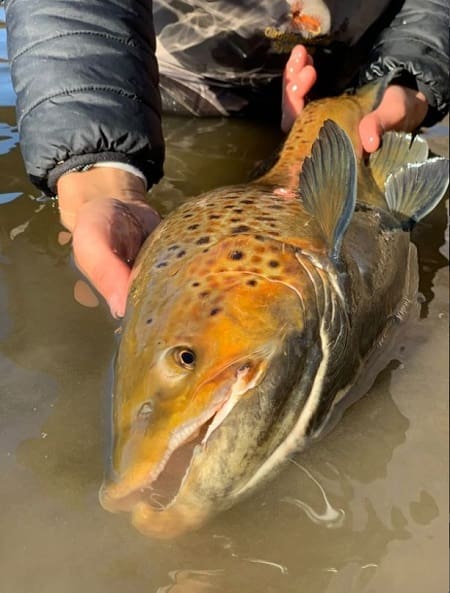
LOL I appreciate your honesty in the conclusion part of the article. At least when you recommend something I know it’s solid. Thanks again for that!
Last year, I noticed a bunch of guys doing very well fishing like that on a specific section of the run. Never tried it before! I’ll give it go just for fun and see what happens…
Hey Oliver,
There is no doubt bobber doggin will catch fish, but I know there are better options so I can’t bring myself to use a less effective method.
Good luck
Graham